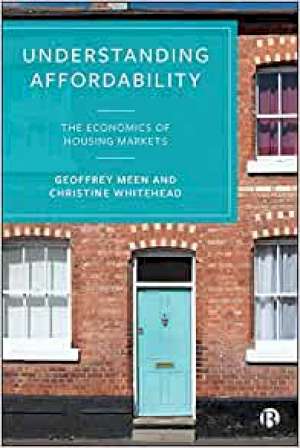26 November 2020
Understanding Affordability:
The Economics of Housing Markets
Geoffrey Meen and Christine Whitehead
2020, Bristol University Press, 336 pages,
ISBN 9781529211856
Reviewer: Dame Kate Barker, British Coal Staff Superannuation Scheme

This book provides a careful analysis of the factors behind what is (too) often described as a housing affordability ‘crisis’ in the UK. In doing so it tells a good deal of the history of post-war housing trends and policy, while politely knocking down several of the commonly-held views on the affordability topic. Meen and Whitehead are experienced and subtle housing market commentators. They point out at the start that too much recent housing work carried out at the macro level does not properly recognise housing’s fundamental attributes and how that drives behaviours and outcomes; part of their purpose is to remedy this. The book is rich in information and themes – inevitably this review doesn’t do it full justice.
How to define affordability? The usual house-price/earnings ratio (HP/E) is dismissed as providing no information across household types and income levels – and as a misleading indicator over time (for example, it does not capture the fall in mortgage interest rates in the UK). Instead, the authors, having considered other methods, look at affordability for First-Time Buyers (FTBs) based on variations of the Lorenz curve and the Gini coefficient. Having used the HP/E myself in the past, I found this section an invaluable corrective. It should certainly be read by those enthusiastic about the presently-proposed standard method of setting local authority plan housing targets.
Moving to the question of modelling house prices – it is established that in the UK the income elasticity of housing demand is higher than the price elasticity. So – as the relative income of the young has been falling – home ownership inexorably becomes harder for them to achieve unless this relative income trend is offset by large rises in housing supply. The buying power of FTBs is not just due to their own economic fortunes; it also reflects the market outcome from the stock of existing owners and renters – including the role of housing as an investment.
The book comments on the long-running dispute about the role of housing supply in creating the ‘housing markets crisis’. On one side are those who argue that weak new supply, due to constraints in the planning system and a lack of competition among home builders, is the major factor behind housing problems. On the other are those who argue that, if market rents are only rising in line with inflation, there cannot be a major issue with housing supply, though supply may not be ideally distributed.
The conclusion here on this topic is that UK trends in new developments following the 1990 planning changes, and international evidence, suggest that planning controls do affect supply and price trends. However, as should be familiar, increases in supply have to be large and sustained to have a significant effect on affordability – and supply alone will not solve all the housing issues facing those on low incomes. It is likely that the UK has both a supply problem and a housing distribution problem. A further chapter considers the impact of planning constraints on the type of housing built, and also on the structure of the homebuilding industry. It is argued that radical change to planning (such as a move to a zoning system) is unlikely – though pretty much such a change has now been proposed in the Planning White Paper which emerged very soon after this book was published.
Other important points covered are: the effect of the wider economic environment on the housing market and on new supply (too often problems thought to be in the housing market actually originate elsewhere); the contribution to regional issues arising from the spatial fixity of housing; the important role that could be played by an enhanced supply of social housing; and, the welfare problems around housing benefit. Those interested in the measurement of inflation might note their arguments about why market rents might move more slowly than imputed rents.
The final chapter turns to possible solutions. It is pointed out that there are often conflicting public policy objectives (mortgage market stability versus FTB access for example). My additional observation is that there is often a lack of clarity about what success for housing (in its totality) would look like. When we talk about a housing crisis, it’s worth noting, as Meen and Whitehead observe, that most households are well-housed and do not have affordability problems. The authors argue that there is now a better general understanding of the how housing markets work, but that this has not made finding good solutions, and implementing them, any easier. Importantly, they point out that a failure to reform planning and taxation has costs, not least in exacerbating housing market volatility.
A set of broad conclusions which emerge are: that demand-side measures have been neglected; that simple affordability measures are being used inappropriately; that a property tax would tackle the insider/outsider issues but is politically infeasible; and that housing policy needs to be better co-ordinated with the benefits of better housing given more weight in policy appraisal techniques. A better method for considering how much new supply a local area should plan for is suggested. But also that behavioural factors matter – in the UK housing is perhaps more of a positional good than in some EU countries.
This is a powerful but careful book resulting from long research in this field by both authors. It is very much not a polemic – but rather a hugely informative account of the underlying problems in our housing market and why they are so very difficult to tackle.
